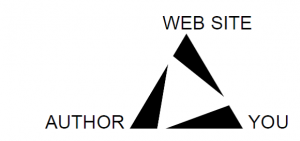Being able to evaluate your sources is one of the main components of writing a research paper. Sources form the foundation of your paper because they help validate your arguments and statements. A source can make a good paper or just simply ruin one. That is why we have decided to create this game to help teach incoming college freshman and others to evaluate sources.
To help support the game on a fundamental level three sources were chosen to give the game credibility. The first source is an Old Dominion information module reading on evaluation criteria that a source should meet to be judged as credible. Its five criteria are currency, relevancy, accuracy, authorship and purpose. The reader is walked through each criterion and is given a brief description of each as well as examples to help them further understand. It also creates a nice acronym to help students remember the criteria for evaluating a source the acronym is CRAAP which is simple and easy to remember.
The second was a how-to titled “Writing the research paper” by Susan Frankel and Nina McHale, it was published in 2002 but it is still relevant. This reading which spans 51 pages documents how to build a proper research paper, from brainstorming your topic to formatting the finished paper. Since the game is based on sources, the section of the reading which we focused on was the source evaluation material, found on pages 8-12 which list various types of sources and each is summarized in regards to how they are credible or what issues they may have; for example magazines are good sources for timely topics but their research at times is not done at a professional level. On page 16 they go over how to judge the credibility of a website, a symbol is used to depict the 3 elements (The author, Website and You) that go into evaluating the source from a website . The “author” part of the symbol asks who created the website and for what purpose. The part of the symbol relating to “website” asks the reader to judge the URL because they often serve as good indicators of what organization may have published the page for examples .edu, .org, or .gov. Finally the part of the symbol concerning you relates to the point that you are the final judge because even if a website meets all of the previous parts of the triangle only you can judge if it is relevant to your topic or if the information is accurate.
. The “author” part of the symbol asks who created the website and for what purpose. The part of the symbol relating to “website” asks the reader to judge the URL because they often serve as good indicators of what organization may have published the page for examples .edu, .org, or .gov. Finally the part of the symbol concerning you relates to the point that you are the final judge because even if a website meets all of the previous parts of the triangle only you can judge if it is relevant to your topic or if the information is accurate.
The third source is an abouteducation.com article titled “5 Bad Research Sources” by Grace Flemming. In the reading Flemming states the importance of knowing how to differentiate between nonfiction and fiction or fact and opinion. This reading goes more in depth in giving an explanation of bad sources by giving clearer reasons as to why these reading formats are deemed as bad sources. For example Blogs are not good sources because any blogger can use the availability of the internet to publish their own opinions regardless of their credibility or their objectivity. This is great for anyone who wishes to let their opinions be heard, but bad for any student doing a research paper. The lack of credentials needed to write a blog is what makes them an unreliable source; essentially any Jane or John Doe can write a blog whenever they have a whim, without any fact checking necessary. The reading goes on to list Personal websites, Wiki sites, movies and historical novels as other forms of bad sources. All of the bad sources listed have one thing in common people can take creative liberties with them, which results in the information at times becoming untrustworthy.
The sources listed above gave some credibility to the game, by making sure the game as a strong learning component to it. The Old Dominion source led to the title of the game because it used a clever acronym that could be remembered by anyone especially a college freshman. It encompasses all of the criteria that they would need to properly evaluate a source. The triangle symbol image from Frankel and McHale will be used as one of the images for the game; the reading will also be used for certain source descriptions. Lastly the Flemming reading will be used to also help with the understanding of what a bad source maybe because it gives several examples of these sources.
This is will be a source evaluation game, users will be asked to apply the C.R.A.A.P test to evaluate the sources in the game. The user will learn how to judge a web page for its validity; it might even be from a blog or a personal website. The game will be over once the user has completed the 5th level of the game but in the demo there will only be two levels. The ultimate goal of the game will be for users to come away with a basic understanding for source evaluation or to at least create some awareness of good and bad sources.


